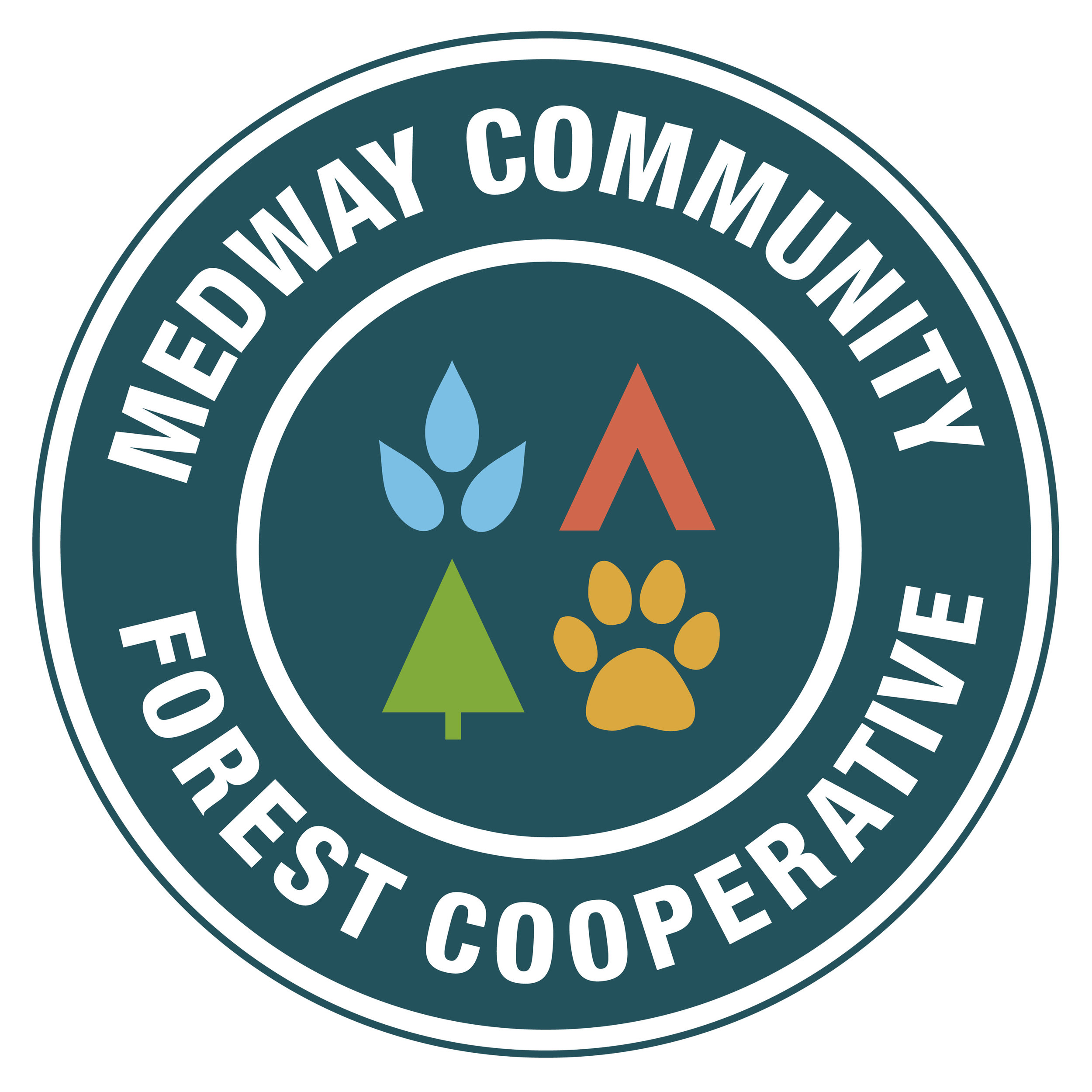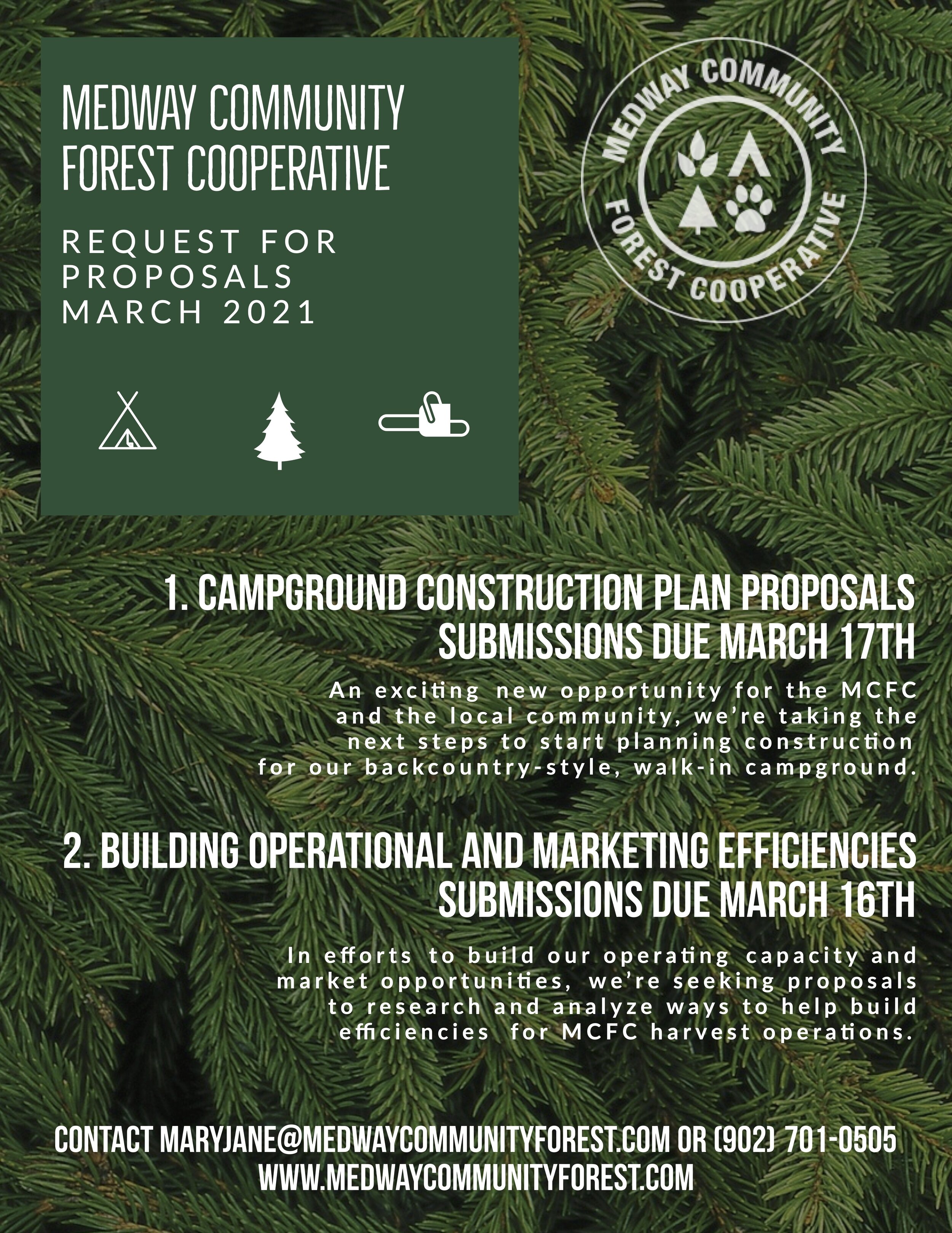Winter Newsletter 2021
We hope you have been enjoying the woods by snowshoe, ski, or sled and keeping warm by a crackling fire. The Medway Community Forest Co-op has been busy this winter wrapping up contract work assessing and treating stands for Hemlock Woolly Adelgid (HWA) on private woodlots, Crown lands, and in Kejimkujik National Park. We’re excited to share that our negotiation committee has again begun active conversations with the Department of Lands and Forestry and are working towards securing a long-term license agreement and building the parameters to support self-sufficiency this year.
What’s New
Upcoming Request for Proposals
MCFC is seeking to procure a detailed construction plan for the development of a 10-site campground nearby Highway 8, in the Stave Lake region of the MCFC license area. The campground will aim to deliver a backcountry camping experience with front country access. The MCFC signed a Letter of Authority with the Department of Lands and Forestry in 2020 and we hope to begin construction in summer 2021. We are looking forward to the day where we can invite you to check out new trails and offer you, and travelers a place to sleep lakeside under the stars!
MCFC was also successful in obtaining a grant under the federal government’s Investment Readiness Program, administered by the Community Foundation of Nova Scotia to ‘Build Efficiencies in Forest Operations and Marketing’. Through this proposal, we are seeking to investigate new methods to facilitate ongoing harvest operations on our license area, identify new local and export markets and expand investment opportunities. Through procuring consultant services, we are also hoping to build contractor capacity with partner organizations including the Western Woodlot Services Cooperative and the Mi’kmaq Forestry Initiative. Click here to see our request for proposals.
Outreach Update
We hosted a webinar on February 2nd with past MCFC Outreach Intern, Heba Jarrar, where she presented her Master of Forest Conservation research project analyzing multispectral imagery collected by drone surveys done in 2019. If you missed it, the webinar was recorded and has been added to our YouTube page. Heba covers some interesting ways we can use technology to support forest management, research, and restoration. With new provincial LiDAR data now available for our region, there is plenty more to explore and ways to utilize these mapping tools.
We are in the process of reviewing many great applications for our 2021 Community Outreach Intern and look forward to a year of community outreach and activities (perhaps in the woods when we can). Keep an eye on our Facebook or the events page for upcoming webinars & such!
Winter in the woods
Photo: Mary Jane (ED) talking with the harvest operator during a regular site visit, getting started on the Spruce Selection Harvest - January 2021
Winter Harvest
After a long hiatus we’ve been happy to have local contractors, RC Weare Logging back and working on in two blocks, one hardwood and one spruce selection harvest. Winter is the ideal time to cut hardwoods since the trees are dormant and the machinery poses less risk for soil disturbance and compaction. The goal of these treatments were to remove 30% of the stand, encouraging growth of healthy young trees and removing trees that are in poor health or have significant defects (while preserving a generous number of cavity and legacy trees). Selection harvests aims to grow the residual trees and allows the trees to sequester more carbon over time.
Photo: January 2021, Hardwood Selection Harvest
Update on the Lahey Review
The MCFC would like to congratulate incoming premier, and previous Minister of Lands and Forestry, Iain Rainkin on his successful campaign to replace Stephen McNeil. With this, we would also like to thank Stephen McNeil, for his efforts in promoting the MCFC during his time in office and perseverance in initiating the Lahey Review. We’re looking forward to sharing insights on ecologically-based community forestry with the new premier.
As the province takes steps towards managing crown land forests through Ecological Forestry by adopting the TRIAD approach. Public consultation on the Department’s ‘Silvicultural Guide for the Ecological Matrix’ (SGEM), which defines the matrix leg of the triad, has just wrapped up. Some changes to highlight include prioritizing biodiversity, considering new science in natural disturbance for management decisions, and greatly reduced clear-cutting in mixed-use matrix zone. We encourage you to check out the SGEM and reach out to the Department in support of full implementation the Lahey review.
Photo: December 2020 - Little Mud Lake area pre-commercial thinning site assessment with MCFC Executive Board Members (left to right) Katie McLean, Abby Lewis, Fritz Meyer, and staff member Jennika Hunsinger
Pre-commercial thinning (PCT)
This winter we have some PCT work in various regions of the MCFC license area. The site pictured was harvested about 10 years ago, and the PCT helps improve the overall health of the regenerating stand when closely spaced, young trees, and clumps are competing with each other.
Hardwoods such as oak and maple commonly sprout many new stems from a previously cut stump. This process is known as coppicing, as the tree’s root system sends out shoots to continue photosynthesis and re-establish, producing clones of the original tree. The operator selects to keep the most dominant, straight, and healthy stem or three in this case (it was a big clump!). In our PCTs, we favour species diversification and each prescription is unique to the stand depending on species, density, and ground conditions. We’re happy to see a good diversity of natural regeneration – not just spruce trees! Our aim is for the work we do today to restore and promote natural Acadian forest conditions for future generations.




